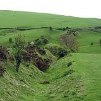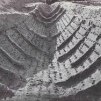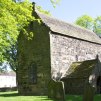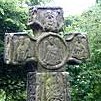From the remains of fortified towers to elegant churches and early Christian crosses, we have scoured the land to bring you the finest Anglo-Saxon sites in Britain. Most of these remains are in England, although a few can be found on the Welsh and Scottish borders, and all of the sites date from between 550 AD to 1055 AD.
You can use our interactive map below to explore the individual sites, or scroll down the page for a full list. Although we have attempted to create the most comphrensive list of Anglo-Saxon sites available on the internet, we’re fairly certain that there are still a few missing! As such, we have included a feedback form at the bottom of the page so you can let us know if we’ve missed any out.
Burial Sites & Military Remains | Anglo-Saxon Churches | Anglo-Saxon Crosses
Burial Sites & Military Remains
| Anglian Tower, York City, North Yorkshire Fortification (Tower) This tower was probably constructed by King Edwin of Northumbria in around 630, and is built into the much earlier Roman city walls of York. There is, however, a great deal of controversy over how old this tower is, with estimates ranging from 400 to 700AD. |
 |
| Black Ditches, Cavenham, Suffolk Earthwork Built in the late 6th century by the Anglo-Saxon kingdom of East Anglia, this earthwork was designed as a defensive measure against the Mercians to the west. Specifically, it was designed to protect the ancient Icknield Way which was a key line of communication and transport at the time. |
 |
| Daw's Castle, nr Watchet, Somerset Fort Built by King Alfred the Great as part of his military reforms, this ancient sea fort sits almost 100 metres above the sea and would have acted as a defensive measure against marauding Vikings coming down the Bristol Channel. It is thought this fort once housed an Anglo-Saxon mint in the early 11th century. |
 |
| Devil's Dyke, Cambridgeshire Earthwork One of a series of defensive earthworks in Cambridgeshire and Suffolk, Devil's Dyke was built by the kingdom of East Anglia some time in the late 6th century. It runs for 7 miles and crossed two Roman roads as well as the Icknield Way, allowing the East Anglians to control any passing traffic or troop movements. Today the Devil's Dyke route is a public footpath. |
 |
| Fleam Dyke, eastern Cambridgeshire Earthwork Much like Devil's Dyke, Fleam Dyke is a large defensive earthwork which was built to protect East Anglia from the kingdom of Mercia to the west. Today there is around 5 miles of the dyke remaining, with the majority of it open as a public footpath. |
 |
| Offa's Dyke, border of England and Wales Earthwork The famous Offa's Dyke runs almost the entirety of the English / Welsh border and was built by King Offa as a defensive border against the Kingdom of Powys to the west. Even today the earthwork spans almost 20 metres in width and 2 and a half metres in height. Visitors can walk the entire length of the dyke following the Offa's Dyke Path. |
 |
| Old Minster, Winchester, Hampshire Church Only the outline of Winchester's Old Minster still remains, although it was fully excavated in the 1960s. The building would have been built in 648 by King Cenwalh of Wessex, and demolished soon after the Normans arrived to make way for a much larger cathedral. |
 |
| Portus Adurni, Portchester, Hampshire Castle Although not strictly an Anglo-Saxon building (it was in fact built by the Romans to protect themselves from Anglo-Saxon invaders!), they did make it their home after the Romans left England in the late 5th century. |
 |
| Snape Cemetery, Aldeburgh, Suffolk Ship Burial Situated deep in the Suffolk countryside lies the Snape Anglo-Saxon burial site dating back to the 6th century AD. Featuring a ship burial, the site was more than likely built for East Anglian nobility. |
 |
| Spong Hill, North Elham, Norfolk Cemetery site Spong Hill is the largest Anglo-Saxon burial site ever excavated, and contains a whopping 2000 cremations and 57 burials! Before the Anglo-Saxons, the site was also used by the Romans and Iron Age settlers. |
 |
| Sutton Hoo, near Woodbridge, Suffolk Cemetery site Perhaps the most famous of all Anglo-Saxon sites in England, Sutton Hoo is a set of two 7th century burial sites, one of which was excavated in 1939. The excavation revealed some of the most complete and well preserved Anglo-Saxon artifacts ever found, including the famous Sutton Hoo helmet which is now on show in the British Museum. The main tumulus is thought to have contained the remains of Rædwald, King of East Anglia, which was set within an undisturbed ship burial. |
 |
| Taplow Burial, Taplow Court, Buckinghamshire Burial Mound Before the discovery of Sutton Hoo in 1939, the Taplow burial ground had revealed some of the most rare and complete Anglo-Saxon treasures ever to be found. It is thought that the burial ground contains the remains of a Kentish sub-king, although due to it's location on the Mercia-Essex-Sussex-Wessex border this is up for debate. |
 |
| Walkington Wold Burials, nr Beverley, East Yorkshire Burial Mound This rather gruesome burial site contains the remains of 13 criminals, 10 of which had been decapitated for their crimes. The skulls of these decapitated corpses were also found nearby, albeit without their cheekbones as these were thought to have decayed whilst the heads were displayed on poles. Walking Wold is the most northerly Anglo-Saxon execution cemetery ever found. |
 |
| Wansdyke Earthwork Stretching for 35 miles through the countryside of Wiltshire and Somerset, this large defensive earthwork was built some 20 to 120 years after the Romans had left Britain. Set to a east-to-west alignment, it is thought that whoever built the dyke was defending themselves against invaders from the north. But who were these invaders...? |
 |
| Wat's Dyke, northern border of England and Wales Earthwork Once considered even more sophisticated than Offa's Dyke, this 40 mile earthwork was probably constructed by King Coenwulf of Mercia to protect his kingdom from the Welsh. Unfortunately Wat's Dyke is nowhere near as well preserved as its counterpart, and rarely rises higher than a few feet. |
 |
Anglo-Saxon Churches
| St Laurence's Church, Bradford on Avon, Wiltshire Church Dating back to around 700AD and likely to have been founded by Saint Aldhelm, this beautiful church has had few if any alterations since the 10th century. |
 |
| Chapel of St Peter-on-the-Wall, Bradwell-on-Sea, Essex Church Dating from around 660 AD, this small church is also the 19th oldest building in England! The church was constructed using Roman bricks from a nearby abandoned fort. |
 |
| All Saints' Church, Brixworth, Northamptonshire Church One of the largest intact Anglo-Saxon churches in the country, All Saint's was built sometime around 670 using Roman bricks from a nearby villa. |
 |
| St Bene't's Church, central Cambridge, Cambridgeshire Church Situated next to Corpus Christi College, St Bene't's is the oldest building in Cambridge and dates back to the early 11th century. Unfortunately only the tower of the Anglo-Saxon building still remains, with the rest being rebuilt in the 19th century. |
 |
| St Martin's Church, Canterbury, Kent Church Built sometime in the 6th century AD, St Martin's Church in Canterbury is the oldest parish church still in use. It is also set within a UNESCO World Heritage Site along with Canterbury Cathedral and St Augustine's Abbey. |
 |
| Odda's Chapel, Deerhurst, Gloucestershire Church Built around 1055, this late Anglo-Saxon chapel was being used as a dwelling until 1865. It is now maintained by English Heritage. |
 |
| St Mary's Priory Church, Deerhurst, Gloucestershire Church This elaborately decorated church is situated only 200 metres away from Odda's Chapel, another Anglo-Saxon building in the village of Deerhurst. It is thought that St Mary's Priory was built sometime in the 9th or early 10th century. |
 |
| St Mary in Castro, Dover Castle, Kent Church Completed in either the 7th or 11th centuries although heavily restored by the Victorians, this historic church is set in the grounds of Dover Castle and even boasts a Roman lighthouse as its bell tower! |
 |
| All Saints' Church, Earls Barton, Northamptonshire Church It is now thought that this church was once part of an Anglo-Saxon manor, although the only original part to survive is the church tower. |
 |
| Escomb Church, Bishop Auckland, County Durham Church Built in 670 with stone from a nearby Roman Fort, this small but extremely ancient church is one of the oldest in England. Look out for a specific Roman stone on the northern side of the church which includes the markings "LEG VI". |
 |
| Greensted Church, nr Chipping Ongar, Essex Church The oldest wooden church in the world, some parts of Greensted date back to the 9th century AD. If you are visiting be sure to look out for the 'Leper's Squint' which is a small hole allowing lepers (who were not allowed into the church) to receive a blessing from the priest with holy water. |
 |
| St Gregory's Minster, nr Kirbymoorside, North Yorkshire Church Built in the early 11th century, St Gregory's Minster is best known for its extremely rare Viking sundial written in Old English, the language of the Anglo-Saxons. |
 |
| St Matthew's Church, Langford, Oxfordshire Church Widely considered as one of the most important Anglo-Saxon structures in Oxfordshire, this church was actually built after the Norman invasion but by skilled Saxon masons. |
 |
| St Michael at the North Gate, Oxford, Oxfordshire Church This church is Oxford's oldest structure and was built in 1040, although the tower is the only original part that still remains. John Wesley (founder of the Methodist Church) has his pulpit on view in the building. |
 |
| Church of St Mary the Blessed Virgin, Sompting, West Sussex Church Perhaps the most stunning of all of England's Anglo-Saxon churches, St Mary the Blessed Virgin boasts a pyramid-style gabled helm which sits on top of the church tower! The church was founded just before the Norman Conquest although some structural changes were carried out by the Knights Templar in the latter half of the 12th century. |
 |
| Stow Minster, Stow-in-Lindsey, Lincolnshire Church Situated deep in the Lincolnshire countryside, Stow Minster was rebuilt on the site of a much older church in the late 10th century. Interestingly, Stow Minster boasts one of the earliest forms of Viking graffiti in Britain; a scratching of a Viking sailing ship! |
 |
| Lady St. Mary Church, Wareham, Dorset Church Due to a rather disastrous Victorian restoration, only a few fragments from the original Anglo-Saxon structure still remain of Lady St. Mary's church, although there is an Anglo-Saxon cross and inscribed stones inside. |
 |
| St Martin's Church, Wareham, Dorset Church Although the church dates to 1035 AD, the only original parts that are still intact are the the nave and a small window to the north of the structure. If you are visiting be sure to look out for the red stars which have been painted onto some of the walls; these were added in the 1600s to commemorate plague deaths in the parish. |
 |
| All Saint's Church, Wing, Buckinghamshire Church This charming little church was built in the 7th century AD for St Birinus on the site of a much older Roman church. In fact, Roman tiles can still be seen in the crypt! |
 |
| St Peter's Church, Monkwearmouth, Sunderland, Tyne and Wear Church (User Submitted) Although the interior of this church underwent a major restoration in the 1870's, most of the original stonework was left intact and unaltered. The earliest parts of the church (the west wall and porch) date from 675AD, whilst the tower was added later in around 900AD. |
 |
| St Mary the Virgin, Seaham, Co. Durham Church (User Submitted) Founded around 700AD, this church boasts an Anglo-Saxon window in the south wall as well as a good example of 'herring-bone' stone work in the north wall. The chancel was built some time later by the Normans, whilst the tower is from the 14th century. |
 |
| St Oswald's Priory, Gloucester, Gloucestershire Church Featuring the only Anglo-Saxon church tower in the northwest, it is thought to have been built between 1041 and 1055. It was raised to its current height in 1588. |
 |
| St Mary's Church, near Swaffham, Norfolk Church Originally a wooden church built around 630AD, much of the current stone structure of St Mary's dates from the late 9th century. Perhaps the most astonishing part of this church are the rare wall paintings on the east wall of the nave, and in particular a rare image of the Holy Trinity dating from the 9th century AD. This is the earliest known wall painting of the Holy Trinity in all of Europe. The ruinous structure of the church was used by Satanists until a local resident called Bob Davey stepped in and began a restoration project in 1992.. |
 |
Anglo-Saxon Crosses
| Bewcastle Cross, Bewcastle, Cumbria Anglo-Saxon Cross Standing where it was originally placed over 1200 years ago, the Bewcastle Cross is set within the churchyard of St Cuthbert's Church in Bewcastle. This cross stands at around four and a half metres high and includes the earliest surviving sundial in England. |
 |
| Gosforth Cross Anglo-Saxon Cross Dating back to the early 900s, the Gosforth Cross is full of carvings from Norse mythology as well as Christian depictions. If you are in London, you can see a full sized replica of the cross at the Victoria and Albert Museum. |
 |
| Irton Cross, Irton with Santon, Cumbria Anglo-Saxon Cross Even older than the Gosford Cross, this stone was carved some time in the 9th century AD and sits in the churchyard of St Paul's in Cumbria. Much like the Gosford Cross, a full sized replica can be seen at the Victoria and Albert Museum in London. |
 |
| Eyam Cross, Eyam Church, Derbyshire Anglo-Saxon Cross After being moved umpteen times during its 1400-year history, it's quite amazing that the Eyam Cross is still almost complete! The cross would have been constructed by the kingdom of Mercia in the 7th century AD. |
 |
| Ruthwell Cross, Ruthwell Church, Dumfriesshire Anglo-Saxon Cross The Ruthwell Cross, situated in the Scottish Borders (then a part of the Anglo-Saxon kingdom of Northumbria), is perhaps most famous for having been inscribed with the earliest known example of English poetry. In order to preserve the cross, it is now located inside Ruthwell church. |
 |
| Sandbach Crosses, Sandbach, Cheshire Anglo-Saxon Crosses (User Submitted) Standing proudly in the market square in Sandbach, Cheshire, are two unusually large Anglo-Saxon crosses dating back to the 9th century AD. Unfortunately during the Civil War the crosses were pulled down and broken into separate parts, and it was not until 1816 when they were reassembled. |
 |
| St Peter's Cross, Wolverhampton, West Midlands Anglo-Saxon Cross This 4 metre high, 9th century shaft of an Anglo-Saxon cross stands on the south side of the church. The highest and oldest site in central Wolverhampton, it is likely to have served as a preaching cross prior to the founding of the church building. |
 |
Have we missed something?
Although we've tried our hardest to list every Anglo-Saxon site in Britain, we're almost positive that a few have slipped through our net... that's where you come in!
If you've noticed a site that we've missed, please help us out by filling in the form below. If you include your name we'll be sure to credit you on the website.





